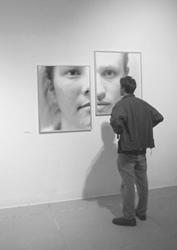

On Tuesday, Fisher Hall introduced the first photography exhibition of the semester, titled "Everything Must Go." The exhibit has garnered much enthusiasm among the community, with photographs illustrating the wide spectrum of creativity and influence present at Oberlin.
Junior Brie Abbe displays a series of five black and white photographs that captures a female subject in various costumes and poses. The first picture reveals the subject standing in a dignified manner, her eyes closed and a salt-like substance falling onto her body. The second work shows the same subject wearing an Eastern-styled outfit with a concerned grimace on her face. Perhaps the most provocative picture in the ensemble is the subject impersonating a pregnant woman while holding a cigarette. The pose and the subject's stare on her enlarged stomach provide ample room for interpretation. Abbe chooses interesting costumes and props that capture perfectly the poses and facial expressions of the subject.

Three black and white photographs by senior James Thomson, cryptically entitled "Entropy, triptych," illustrate the decay of objects through time. The first picture shows a large rock to the left, a pile of smaller rocks in the middle and then a pile of rubble on the far right. The two other photographs follow the same design of deterioration, substituting a piece of wood and a leaf for the rocks. The choice of a white background highlights effectively the decomposition of tangible objects. The artist conveys the simple truth of time passing and left an element of mystery in his thermodynamic title.
Senior Maia Skutel's work, five separate photographs wedged together with the sides overlapping, comprise a unified picture of a large pond next to a barn. With some incongruous elements of the pastoral scene, the work evoked a sense of discontinuity. However, the concept had merit, and evoked in the viewer a feeling of finding an old photograph buried for years in a shoebox up in the attic.
Moving down the wall, senior Zack Lehrhoff showcases six pieces, five of which show a road passing through a forest. These nature photographs utilize the power of shadows cast from the trees. However, the overwhelming darkness and overall blurring of the first five photographs fails to achieve any particular focus of concentration for the viewer. The sixth photograph illustrates a city scene with a concentration on a FedEx truck. This particular photograph has a clear focus on the vehicles and blurs the distant office buildings smoothly.
Located in a separate room of Fisher Hall behind a black curtain and illuminated by special lights, five negatives are showcased by senior Canaan Silberberg. The pieces consist of random brush strokes, layers of plastic and Scotch tape. Outside the separated room, the artist shows three products from the negatives. These three pieces effectively use smudges, colors, and markings to embellish such objects as a subscription card and a drawing of a ghastly face.
Senior Pauline Shapiro offers three close-up black and white photographs of a root developing in loose soil, though this is up to the viewer's interpretation. The perspective shots were effective in focusing on the object and made the surrounding scenery appear very distant. The ambiguity of the content allows the viewer to derive multiple perspectives on her work.
Senior Daniel Romano contributed two large black and white pictures that comprise one large face. The first photograph contains a close-up of the left half of a woman's face while the second photograph contains a close-up of the opposing right half of the face. The detail and size of the two works illuminate the contours of the face and especially the detail and reflection of the eyes. The two photographs are separated by a small gap and level together at the lips. The content of the pictures as well as the placement of the pictures on the wall contribute equally to a striking final product of the immense face.
Junior Eleanor Gillers offers a pair of works, each of which combines two smaller photographs of the same subject inside the same room. By matching the contours of the room in both pictures, the overall piece produces an image of two clones relaxing in one space. The first piece shows the subject watching television in a living room while her clone stands reading.
However, the clear division line between the meshed photographs detracts from the overall appearance and falls short of the intended continuity. The second picture works with the same concept, though only in a kitchen. The subject sits and eats while her clone applies detergent on a sponge. But the pictures do not exhibit any interesting contents and become only an exercise in fitting two photographs together to achieve one photograph of two identical people in a room.
The final works are two large black and white still life photographs shot by senior James Thomson. The first picture shows a trench coat hanging from an open door. The subject matter of this picture is not particularly compelling, but the camera perspective allows the ceiling to assume an interesting sharp angle upwards. The second piece consists of an open oven partially blocked by the corner of a table in the foreground. The simplicity of the subjects in this photo (aptly titled "Empty Oven") allow the corner table leg to catch the viewer's eye in contrast to the oven.
The photo exhibition contains many diverging styles, ranging from Silberberg's cascade of colors over a subscription card to Romano's displaced face. The diversity in design, themes and approach make this exhibition a good example of a healthy, thriving arts community.
"Everything Must Go" runs through February 27, at Fisher Hall. There will be a closing reception on Feb. 25 at 8 p.m. in Fisher Hall.
Now this is art: Senior James Thomson admires fellow senior Daniel Romano's piece. (photo by Tyler Kord)
Copyright © 2000, The Oberlin Review.
Volume 128, Number 13, February 11, 2000
Contact us with your comments and suggestions.